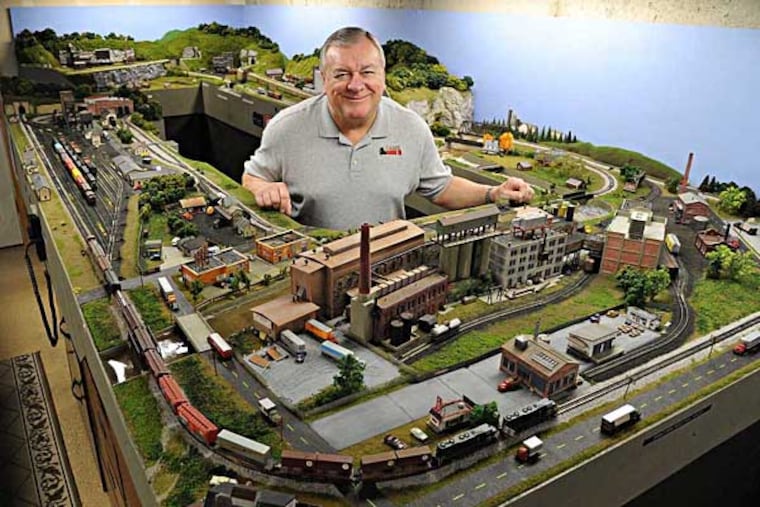Model-train club, one of nation's oldest, chugs on
In many other homes, it would be a dark and cluttered closet. But the door at the bottom of Bob Gross' basement steps opens to another world.

In many other homes, it would be a dark and cluttered closet. But the door at the bottom of Bob Gross' basement steps opens to another world.
Railroad tracks run from a coal mine, over bridges, through mountains, and into train yards. A trolley circles a 1950s-style city dotted with miniature cars and people. Sound effects - train whistles, bubbling brooks, rumbling freight cars - bring the scene to life.
"My wife would tell you that I spend all my time here, and occasionally she throws food down the steps," said Gross, 67, a retired facility manager.
It took Gross 14 years to fill the 12- by 24-foot room in his Newtown Square home with a model railroad.
But he does not spend all of his time working by himself. Gross is president of the Glenolden Association of Model Railroaders. The club celebrates its 75th anniversary this year and says it is one of the oldest model-railroading groups in the country.
Unlike other railroad clubs, the Glenolden group does not rent space to keep a shared train set. The 22 men meet monthly at one member's home.
Six men founded the club in 1939, inspired by train sets on display at a bicycle shop in Glenolden. None of the current members lives in the Delaware County borough, but the group maintains its name.
Model railroading remains a popular hobby nationwide - at least among a generation that grew up in the mid-20th century, gazing at model trains in store windows and learning about real railroad lines. The National Model Railroad Association has more than 18,000 members and draws crowds to its annual conventions. It lists hundreds of local railroad clubs on its website.
The men in the Glenolden club, many of whom are retired, admit that railroad hobbyists are aging. They lost three members in the last year to age or health-related reasons.
There are "not a lot of young people coming into the hobby," said Sam Parker, 77, the group's treasurer.
David Morrow, the club's vice president, has been a member for 30 years. The 86-year-old recalls field trips to hobby shops and train shows, and is known as the club's historian.
Morrow still has the first model railroad his father gave him, in 1935. It cost $35.
A locomotive set now sells for between $100 and $500, though many hobbyists prefer to buy pieces to construct their own sets, Parker said.
For Parker and other railroaders, the hobby grew from a childhood memory of model trains running around the Christmas tree. Now, keeping his model railroad is a year-round, labor-intensive hobby.
The N-scale model (1/160th the size of a real train) in Gross' basement sits on a platform he built himself. He pieced together the trains, buildings, rock formations, trees, and bridges. The train operation and sound effects required electrical wiring. He purchased tiny cars, figurines, and billboards to position on the set. When his grandchildren visit, he lets them run the trolley through his little city.
"There's the basic routes part of it," Gross said, and then "there's the creative aspect."
Although club members are aging, Gross thinks model railroading has a future and hopes to recruit new railroaders. At one recent meeting the group heard a presentation about building models through a computer program.
The Internet offers more options to purchase parts, Gross said, even if "it's kind of like buying a suit through the mail. You can't really try it on." And 3-D printers make it possible to quickly transform custom sketches into real train cars.
"We want to stay current," Gross said.
BY THE NUMBERS
14
years for Bob Gross to build his current model railroad.
22
members comprise the Glenolden Association of Model Railroaders.
18,000
members in the National Model Railroad Association.
$500
the cost of a high-end model locomotive.
EndText